Wonderfully tangy and probiotic, here’s how to make cultured butter and real buttermilk for your favorite recipes… from compound butter to buttermilk biscuits!
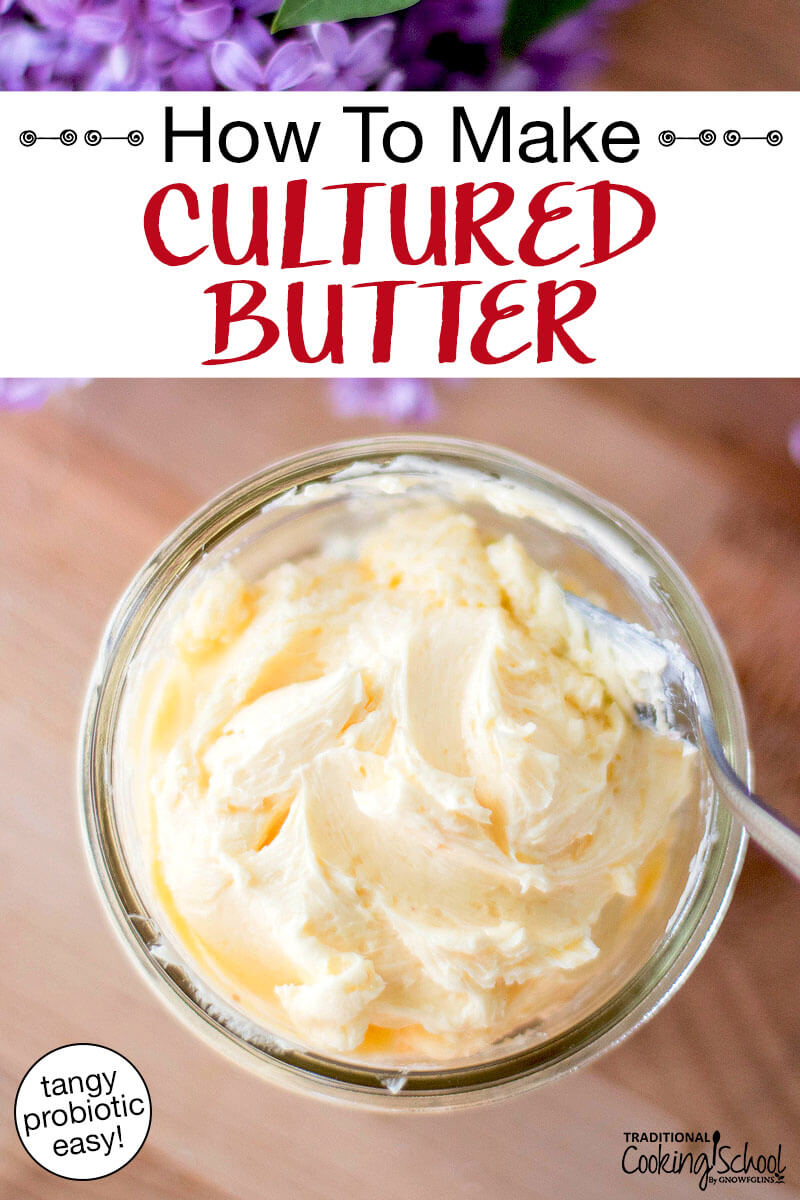
Table Of Contents
What Is Cultured Butter?
Cultured butter starts with cultured cream… cream that is first allowed to ripen or culture before becoming butter. The result: more beneficial organisms (probiotics), enzymes and vitamins.
You can use cultured butter in any dish where you’d use sweet (uncultured) butter. Enjoy the subtle tangy flavor!
Ingredients
- Heavy cream – This can be raw or pasteurized, but not ultra-pasteurized. Choose the best quality you can, preferably raw cream from a grass-fed animal. Yet if this is not possible for you, remember that if you’re culturing dairy at home, you’re making whatever milk you are able to get better!
- Culture of choice – If using raw cream, you don’t have to add a mother culture (though you may choose to do so!) because the beneficial organisms in the cream will proliferate over time themselves, producing a cultured cream or sour cream. You definitely need to add a starter culture if using pasteurized cream because it contains no beneficial organisms to proliferate and/or protect against spoiling. Choose a mesophilic cheese culture such as this one, or plain yogurt, dairy kefir, buttermilk or sour cream with active cultures, or dairy kefir grains.
- Sea salt – Optional, yet delicious! Choose a high-quality, fine-grain, mineral-rich salt. Don’t use store-bought, commercial iodized salt.
Tools & Equipment
- Glass jars – You will need a pint-sized glass jar for culturing the cream, then two half-pint jars for storing the butter and buttermilk afterward.
- Paper towel or cloth napkin, plus rubber band – For covering the cream while it cultures.
- An appliance for churning – You can use your food processor, blender, mixer, or even a glass jar that you shake, shake, shake!
How To Make Cultured Butter
Follow the instructions below to make cultured butter at home, or skip the Culturing step to make sweet cream butter!
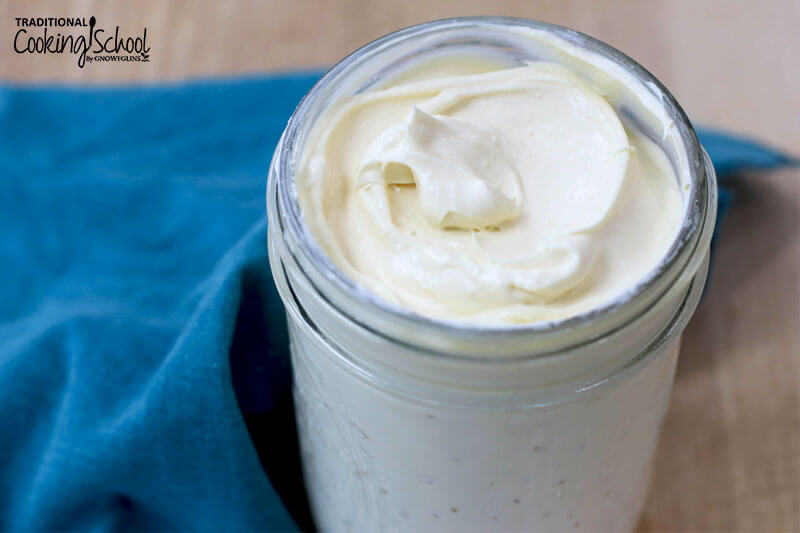
Stage 1: Culturing
- Culture the cream, either by letting raw cream culture spontaneously at room temperature, or by adding a starter culture of your choice to a quart of raw or pasteurized cream.
- Stir the culture in well.
- Cover the jar with a cloth napkin or paper towel, and secure with a rubber band.
- Let the cream culture, or ripen, at room temperature for about 24 to 48 hours.
- To know it is done, go by taste or smell. I think when it tastes like good sour cream it makes wonderful butter! Don’t worry if it is thick or not, as that doesn’t matter. Mainly the culturing stage is to develop flavor and to allow the beneficial organisms to proliferate.
- When it is ready, cover it with a regular lid and move it to the refrigerator and chill it thoroughly.
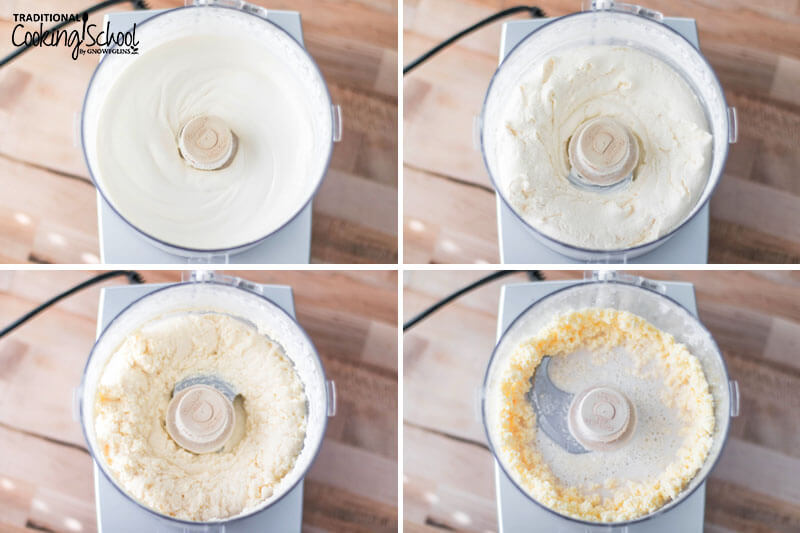
Stage 2: Churning
- Bring the soured cream out of the refrigerator and allow to warm up for about an hour at room temperature.
- Put it into the container of your food processor, blender or mixer. While it is on (for a few minutes to several), the cream will pass through stages: from whipped cream to chunky cream and past that to where the butter “breaks.” Breaking means the butterfat clumps together separately from the buttermilk (the liquid that is the byproduct of butter-making). If the cream is not very cold, the whipped cream stage may get skipped.
- Once the butter breaks, blend for about 30 seconds longer to make sure all the butter has broken out of the buttermilk.
- If using a glass jar for churning, just shake and shake and shake until you get butter!
- Pour off the liquid buttermilk through a fine mesh sieve or strainer into a catch bowl. Save this for soaking grains, salad dressings, smoothies or drinking plain (though I like to add salt). Put the butter solids in a clean mixing bowl. There may be some liquid that comes with them — just pour it off into the bowl of buttermilk.
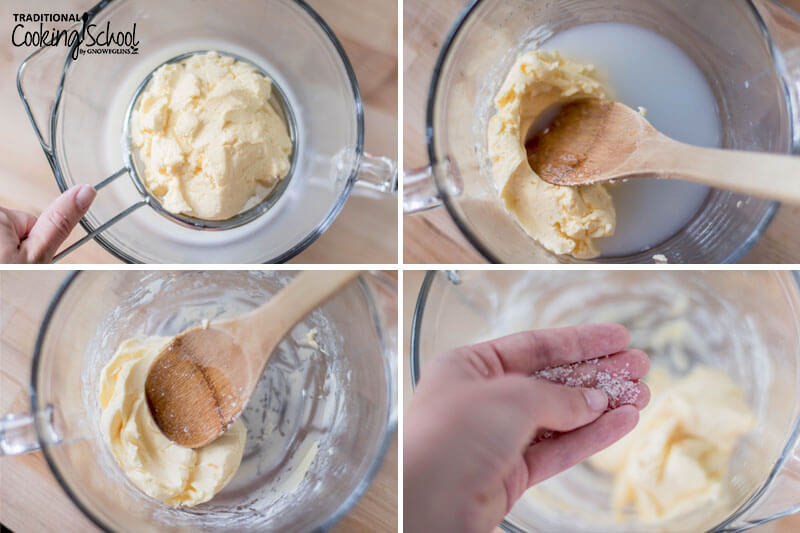
Stage 3: Washing & Pressing
- Add cold water to the bowl of butter solids.
- Over and over, fold and press the churned butter into the sides of the bowl with a wooden spoon. The water will get cloudy from the release of the remaining buttermilk mixed in with the butter solids. Getting these out helps the butter keep better and longer — the buttermilk is what will spoil first.
- Pour off the cloudy water.
- Add more clean water, and press and fold again. You need to keep adding clean water until the water stays clear through a cycle of pressing and folding.
- Then add a final few minutes of just pressing the butter against the sides of the bowl (without additional water) to release any final drips of fluid — to keep the butter fresher longer.
Stage 4: Salting & Molding
- Mix in salt to taste. Using high-quality sea salt will introduce trace minerals into your butter — always a good thing!
- You can shape the butter into patties or logs on wax paper, put it in a small glass jar, or use a butter mold.
- Butter keeps in the refrigerator for a few weeks. The better washed and pressed it is, the better it keeps. If you want it to last longer, freeze it.
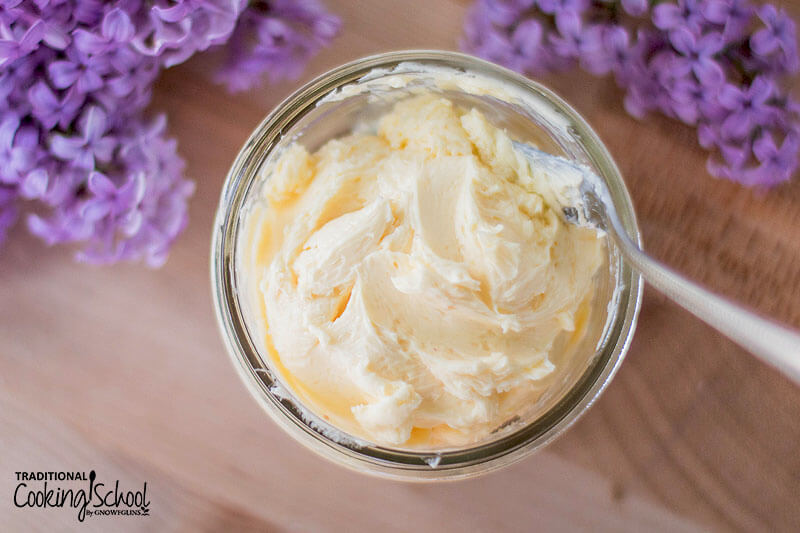
Cultured Butter FAQs
Is it better to use a starter culture rather than using a food (sour cream, buttermilk, yogurt, etc.) with active cultures to inoculate a ferment?
The advantage to using starter cultures is, if they are new and not degraded from being stored too hot, you can ensure a better result. Having said that, either can be used in this instance and if one option is much more economical for you, you can go with that!
My sour cream is taking a long time to thicken. How long is it safe to keep out?
Ideally, it would be set up for you in 3 days or less. Toss it if it’s been more than 3 days.
My butter tastes or smells funny. Why?
It would have do with the original cream and its quality and/or age. Try making cultured butter with fresh cream next time, and/or find a different source of cream.
How long does buttermilk keep?
About 2 weeks, in the fridge.
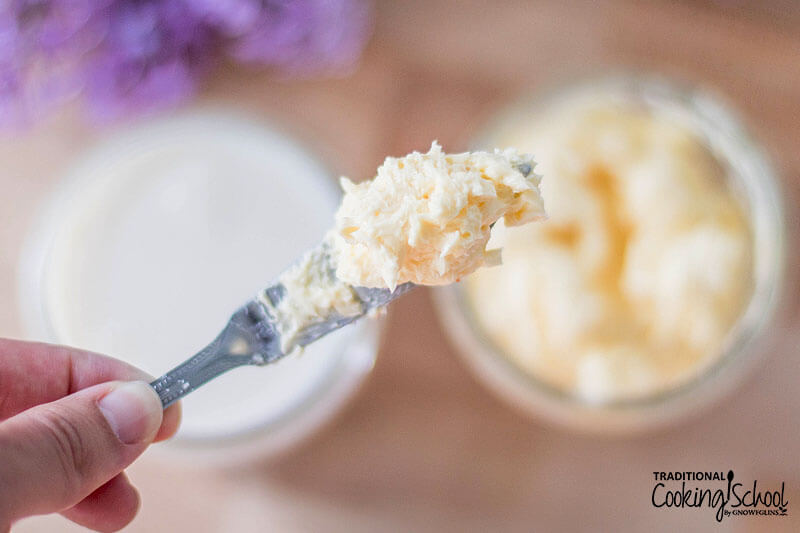
How long will cultured butter last?
A few weeks in the fridge, or longer in the freezer.
How can I use cultured butter?
Use cultured butter anywhere you’d use regular, sweet cream butter… on toast or English muffins, on your morning oatmeal, in baked goods, you name it!
Can I freeze cultured butter?
Definitely! If you have a surplus of raw cream, churning it into butter and freezing it is a fantastic way to store it long-term. I like to wrap logs of cultured butter in parchment or wax paper, then place individual logs in a zip-top bag for freezing.
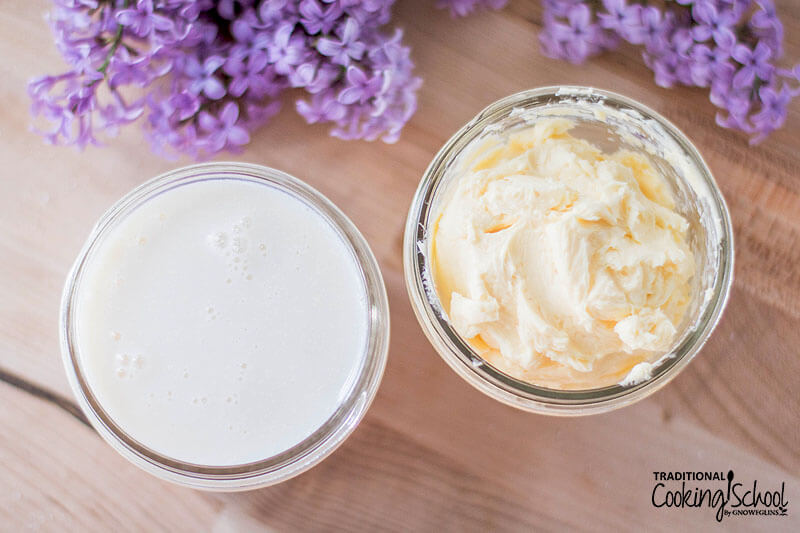
Other Cultured Dairy Recipes
- Compound Butter {Butter Gets Dressed Up!}
- How To Make Homemade Buttermilk + 5 Buttermilk Substitutes
- Easy Sour Cream (with free video!)
- What To Do With Soured Cream?
- Homemade Cottage Cheese From Raw Goat Milk
- Trim Healthy Mama Fuel Pull Cottage Cheese {homemade}
- Cultured Cream Cheese (+5 flavor options!)
- How to Make Raw Milk Mascarpone: Soft, Probiotic Cheese
- Middle Eastern Kefir Cheese Balls {with free video!}What To Do With Soured Cream?
- Homemade Raw Cheddar Cheese
- How To Skim Cream… The Best Way! #AskWardee 114
- Our Family’s Weekly Cultured Dairy Routine #AskWardee 146
- Fermenting Trouble Shooting FAQ’s
Did you make this homemade cultured butter recipe? If so, please give us a rating on the recipe card below. Then snap a photo and tag us on social media so we can see how you enjoyed it!
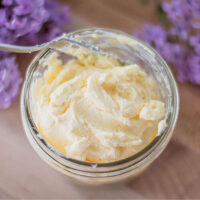
How To Make Cultured Butter
Follow the instructions below to make cultured butter, or skip the Culturing step to make sweet cream butter! This recipe yields a scant 1 cup of cultured butter, and 1 cup of buttermilk.
Ingredients
- 1 pint heavy cream raw or pasteurized
- 1/8 teaspoon mesophilic cheese culture or 1/8 to 1/4 cup store-bought plain yogurt, buttermilk, or sour cream with active cultures; or dairy kefir grains
- fine sea salt 1/4 to 1/2 teaspoon of sea salt per pound of butter
Instructions
Stage 1: Culturing
-
Either let the raw cream culture spontaneously at room temperature, or add a starter culture of your choice to a quart of raw or pasteurized cream.
-
Stir the culture in well.
-
Cover the jar with a cloth napkin or paper towel, and secure with a rubber band.
-
Let the cream culture, or ripen, at room temperature for about 24 to 48 hours.
-
To know it is done, go by taste or smell. I think when it tastes like good sour cream it makes wonderful butter! Don’t worry if it is thick or not, as that doesn’t matter. Mainly the culturing stage is to develop flavor and to allow the beneficial organisms to proliferate.
-
When it is ready, cover it with a regular lid and move it to the refrigerator and chill it thoroughly.
Stage 2: Churning
-
Bring the soured cream out of the refrigerator and allow to warm up for about an hour at room temperature.
-
Put it into the container of your food processor, blender or mixer.
-
While it is on (for a few minutes to several), the cream will pass through stages: from whipped cream to chunky cream and past that to where the butter “breaks.” Breaking means the butterfat clumps together separately from the buttermilk (the liquid that is the byproduct of butter-making). If the cream is not very cold, the whipped cream stage may get skipped.
-
Once the butter breaks, blend for about 30 seconds longer to make sure all the butter has broken out of the buttermilk.
-
If using a glass jar for churning, just shake and shake and shake until you get butter!
-
Pour off the liquid buttermilk through a strainer into a catch bowl. Save this for soaking grains, salad dressings, smoothies or drinking plain (though I like to add salt).
-
Put the butter solids in a clean mixing bowl. There may be some liquid that comes with them — just pour it off into the bowl of buttermilk.
Stage 3: Washing & Pressing
-
Add cold, clean water to the bowl of butter solids. Over and over, fold and press the butter into the sides of the bowl with a wooden spoon. The water will get cloudy from the release of the remaining buttermilk mixed in with the butter solids. Getting these out helps the butter keep better and longer — the buttermilk is what will spoil first.
-
Pour off the cloudy water.
-
Add more clean water, and press and fold again. You need to keep adding clean water until the water stays clear through a cycle of pressing and folding.
-
Then add a final few minutes of just pressing the butter against the sides of the bowl (without additional water) to release any final drips of fluid — to keep the butter fresher longer.
Stage 4: Salting & Molding
-
Mix in salt to taste. Using a high-quality sea salt will introduce trace minerals into your butter — always a good thing!
-
You can shape the butter into patties or logs on wax paper, put in a small glass jar, or use a butter mold.
-
Butter keeps in the refrigerator for a few weeks. Or the freezer for longer storage. The better washed and pressed it is, the better it keeps. If you want it to last longer, freeze it.
Recipe Notes
*If using raw cream, you don’t have to add a mother culture — though you may choose to do so! — because the beneficial organisms in the cream will proliferate over time themselves, producing a cultured cream or sour cream. You definitely need to add a starter culture if using pasteurized cream because it contains no beneficial organisms to proliferate and/or protect against spoiling.
This post was originally published and written by Wardee Harmon in 2010. It was updated and republished on 5/19/21.
...without giving up the foods you love or spending all day in the kitchen!

2 free books:
Eat God's Way
Ditch the Standard American Diet, get healthier & happier, and save money on groceries...
We only recommend products and services we wholeheartedly endorse. This post may contain special links through which we earn a small commission if you make a purchase (though your price is the same).


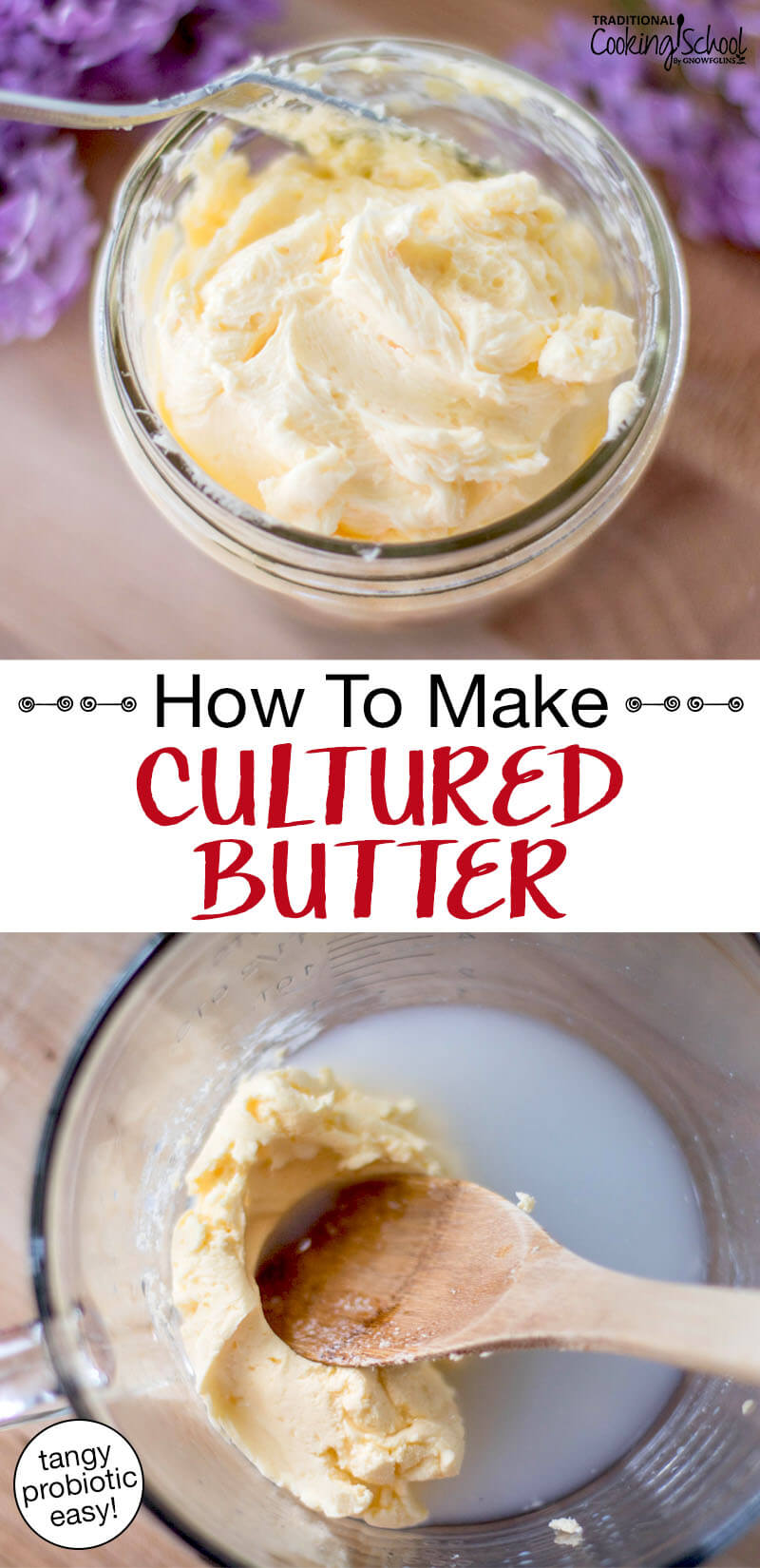
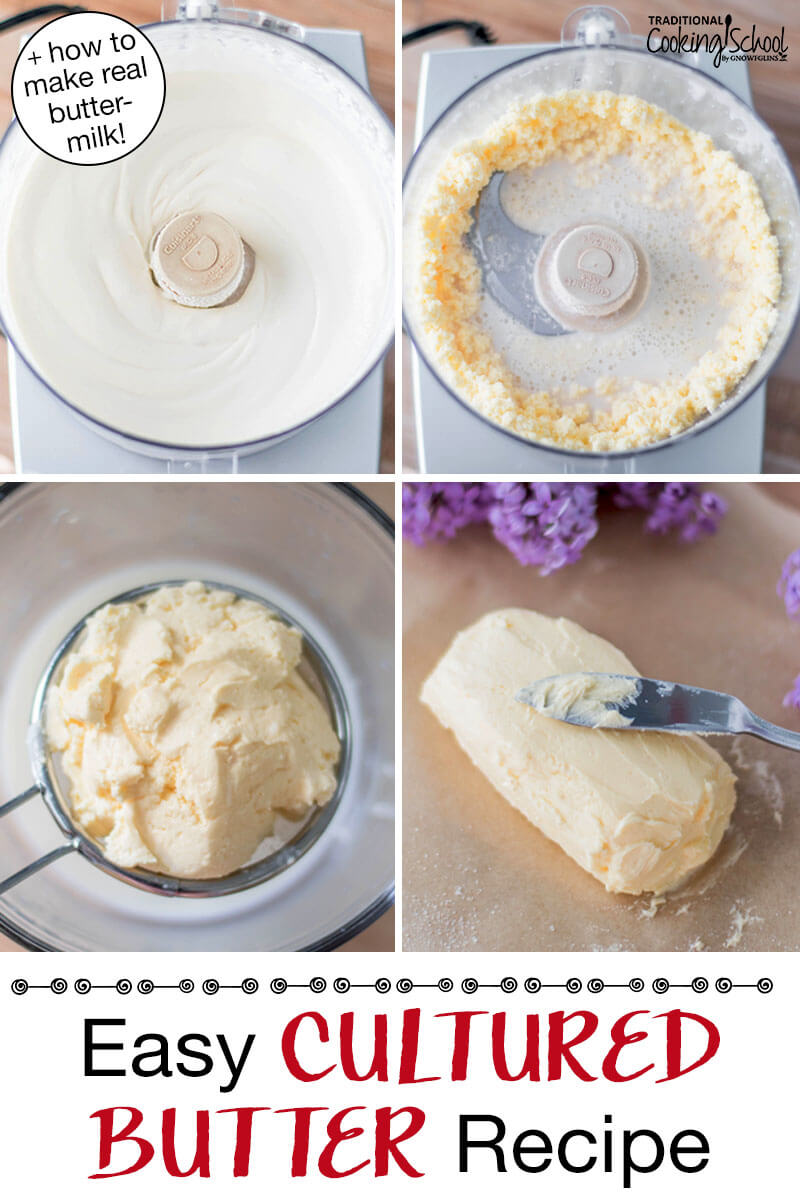
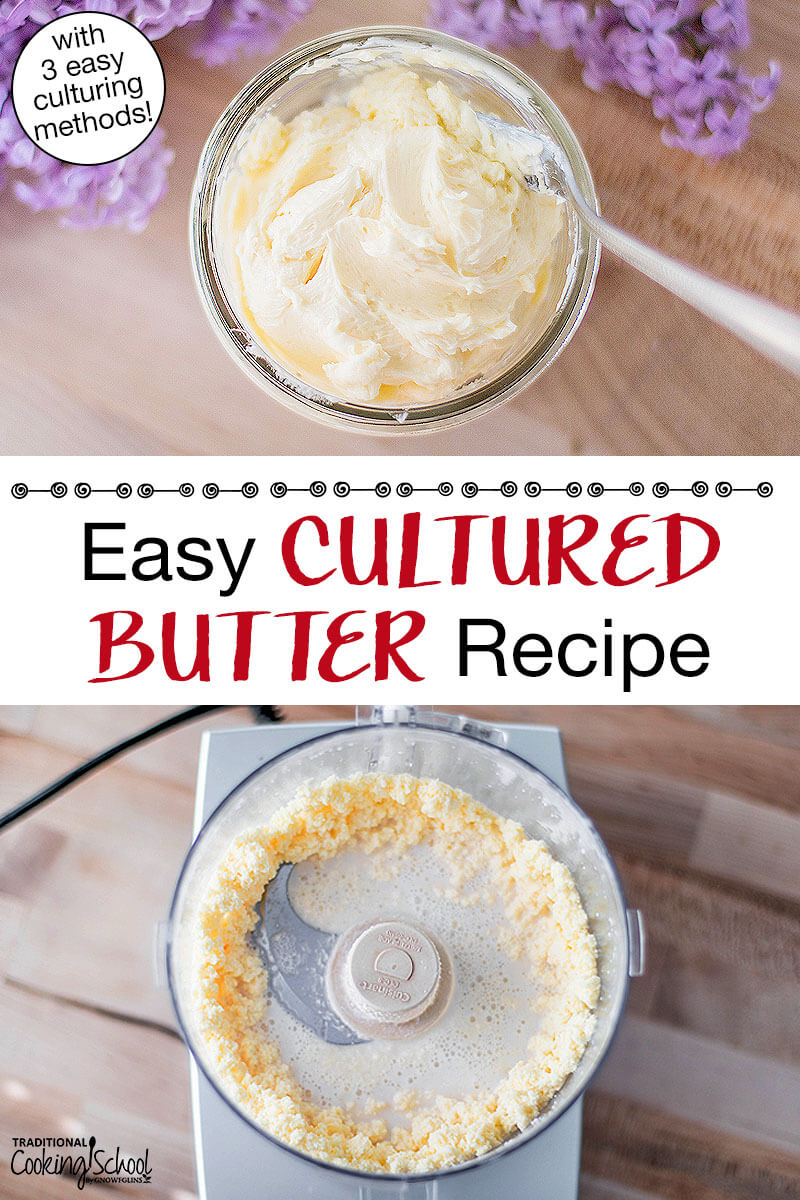
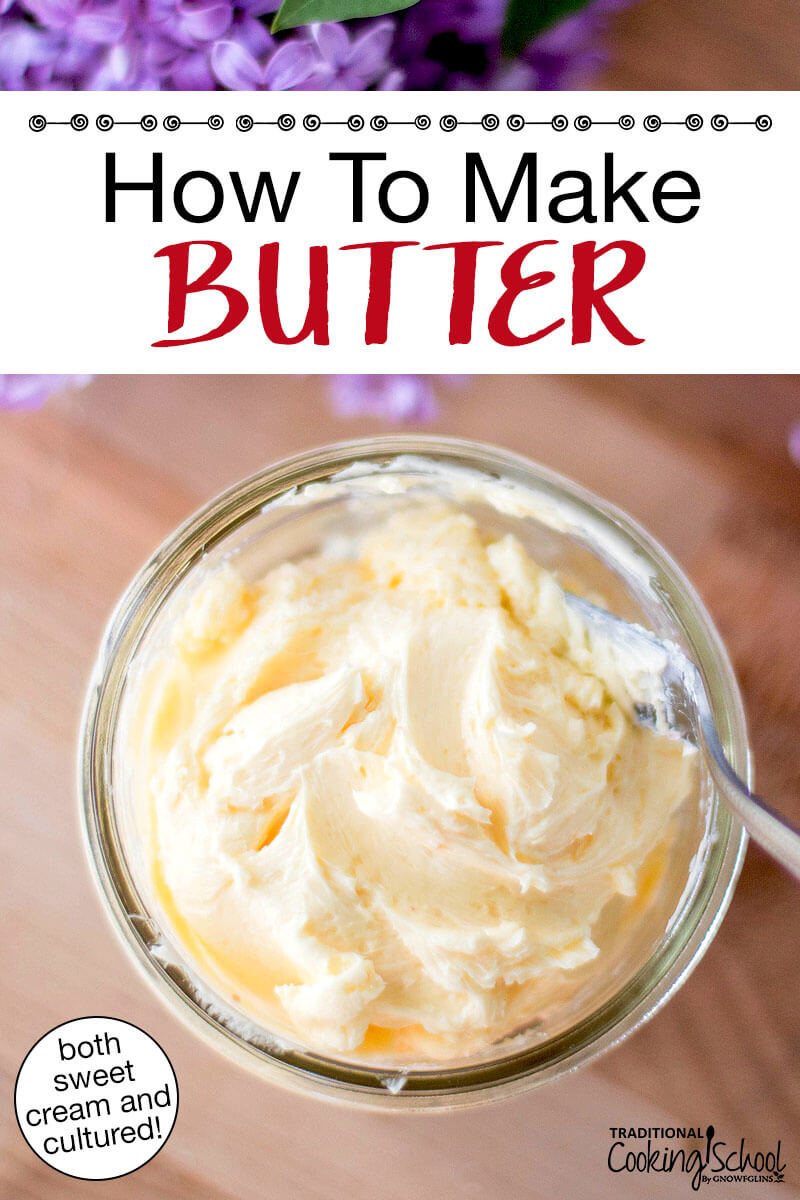
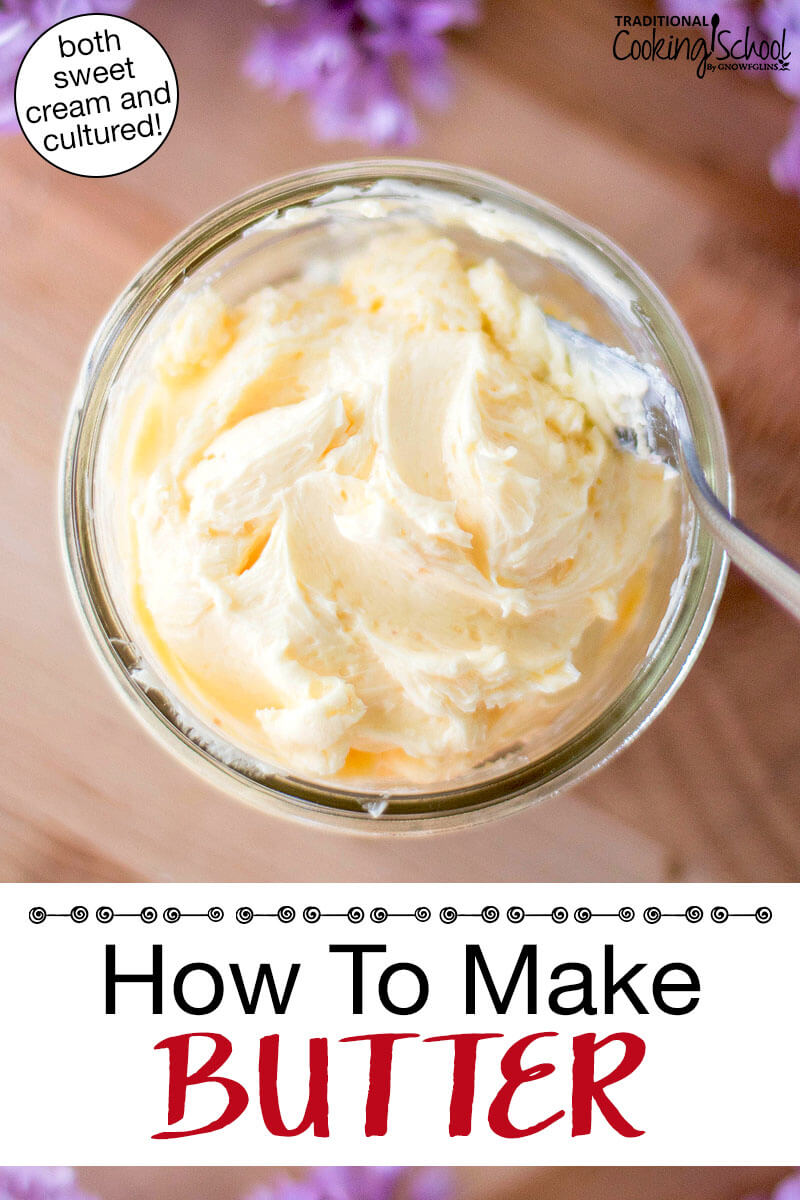
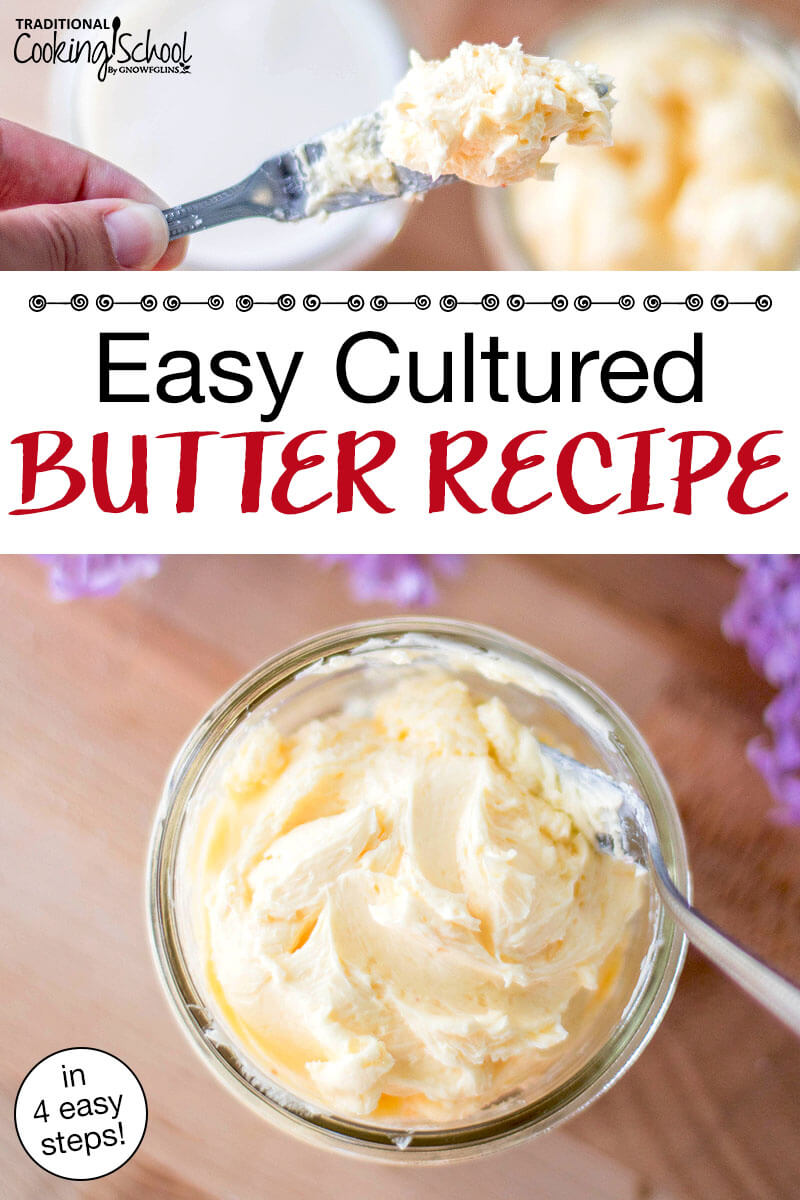
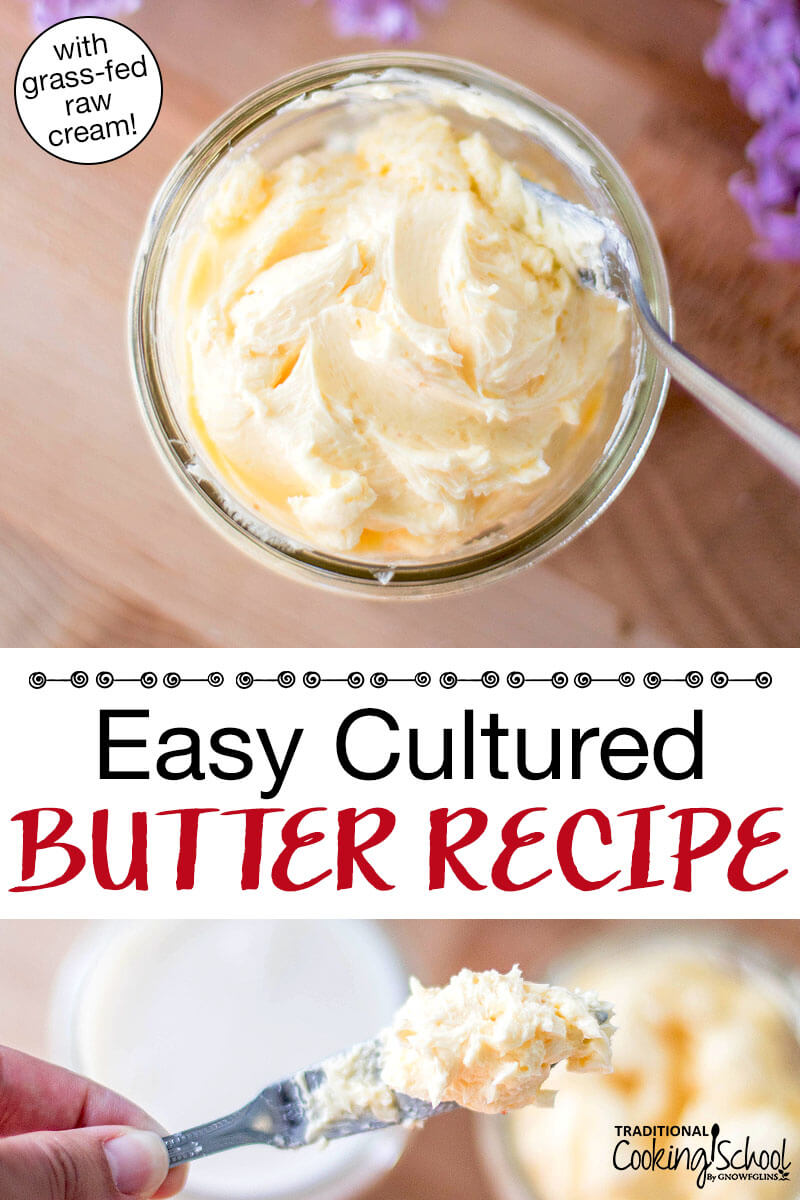
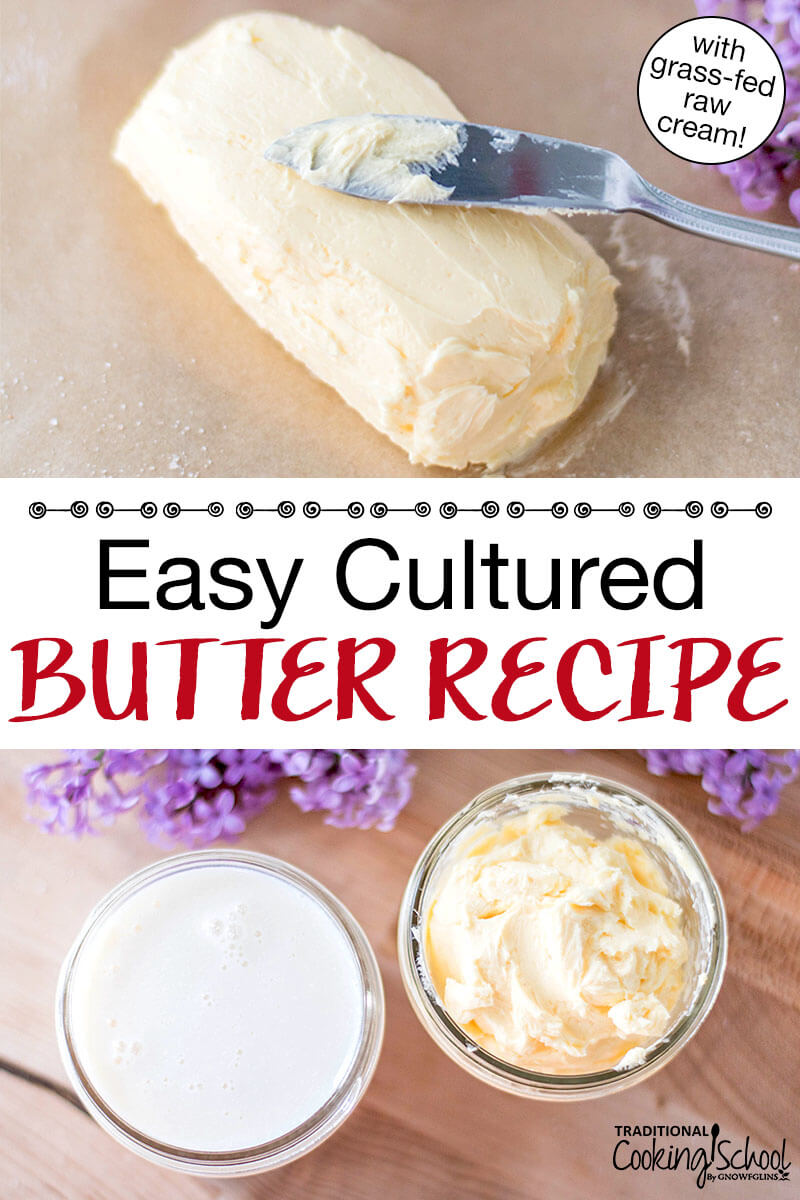
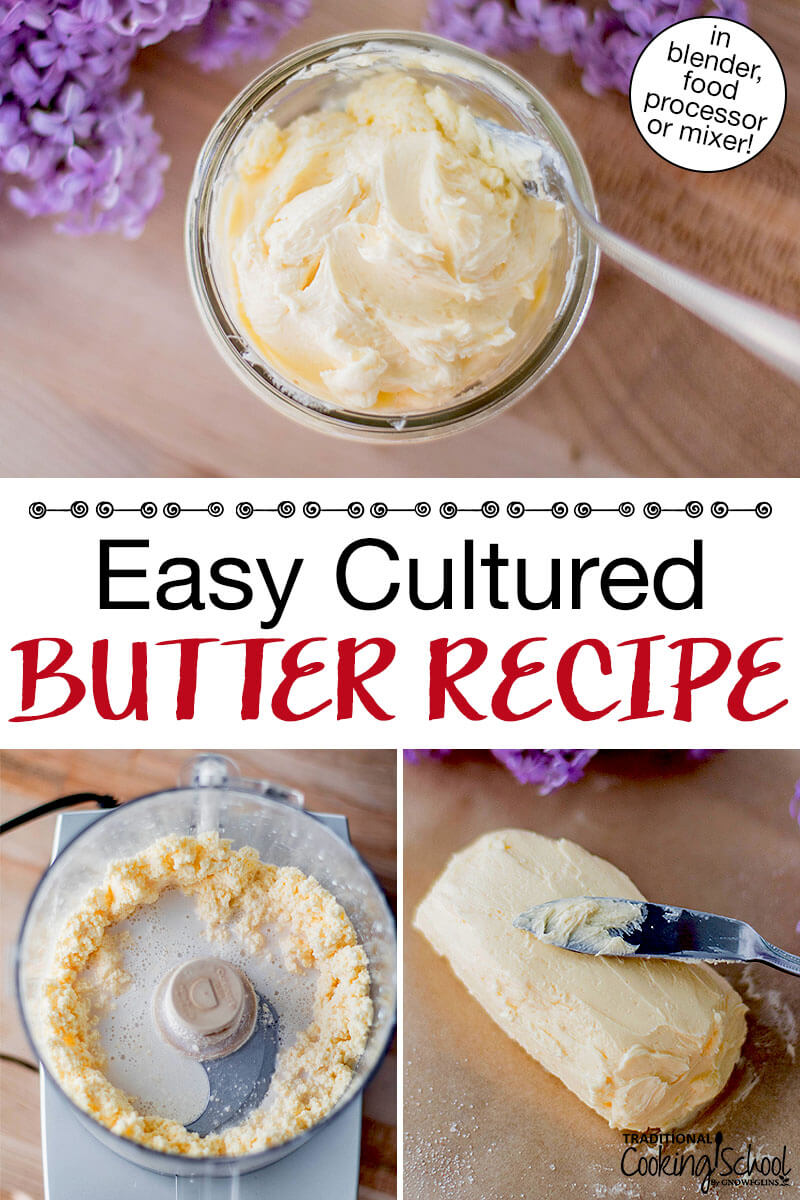
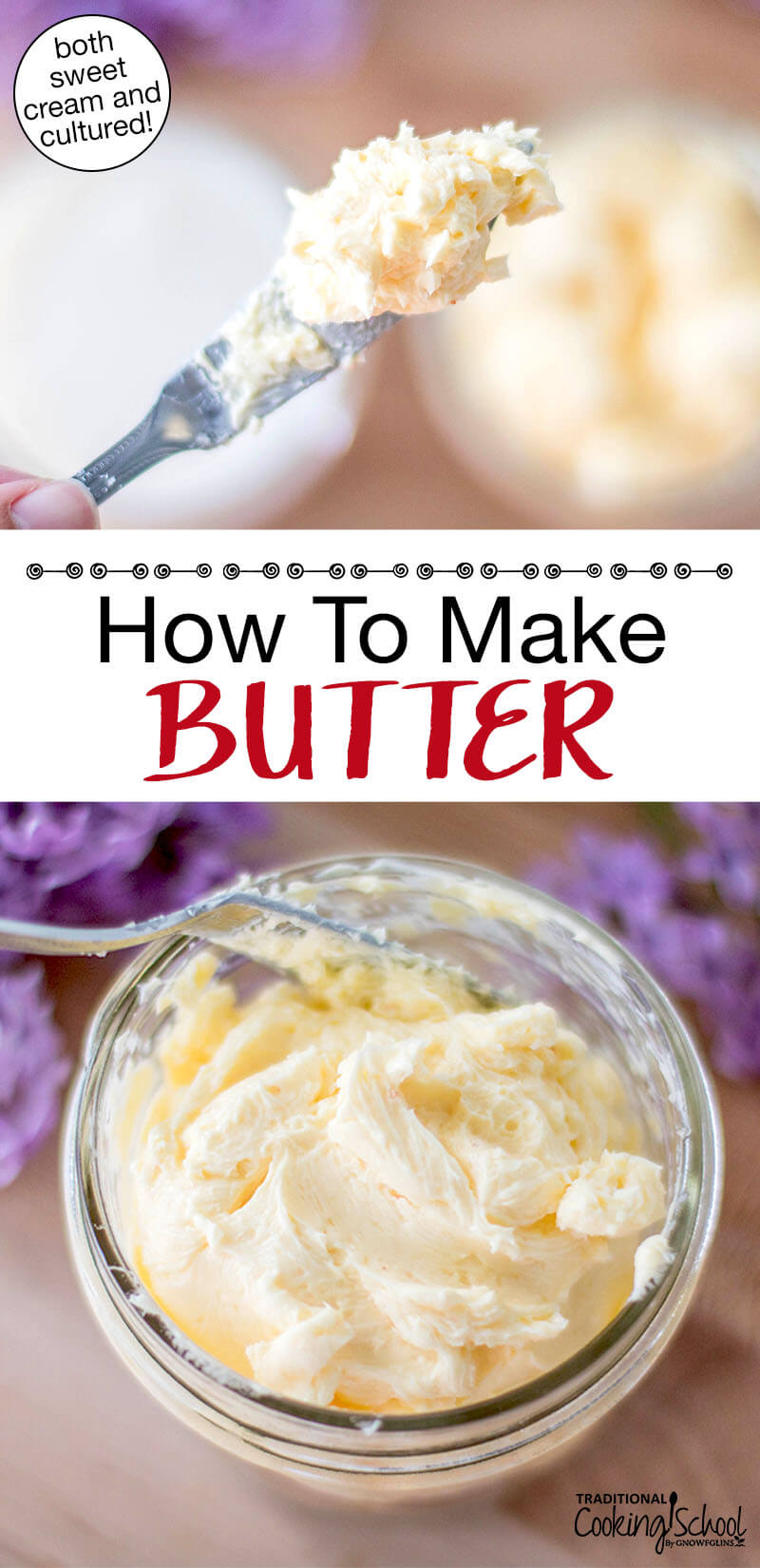

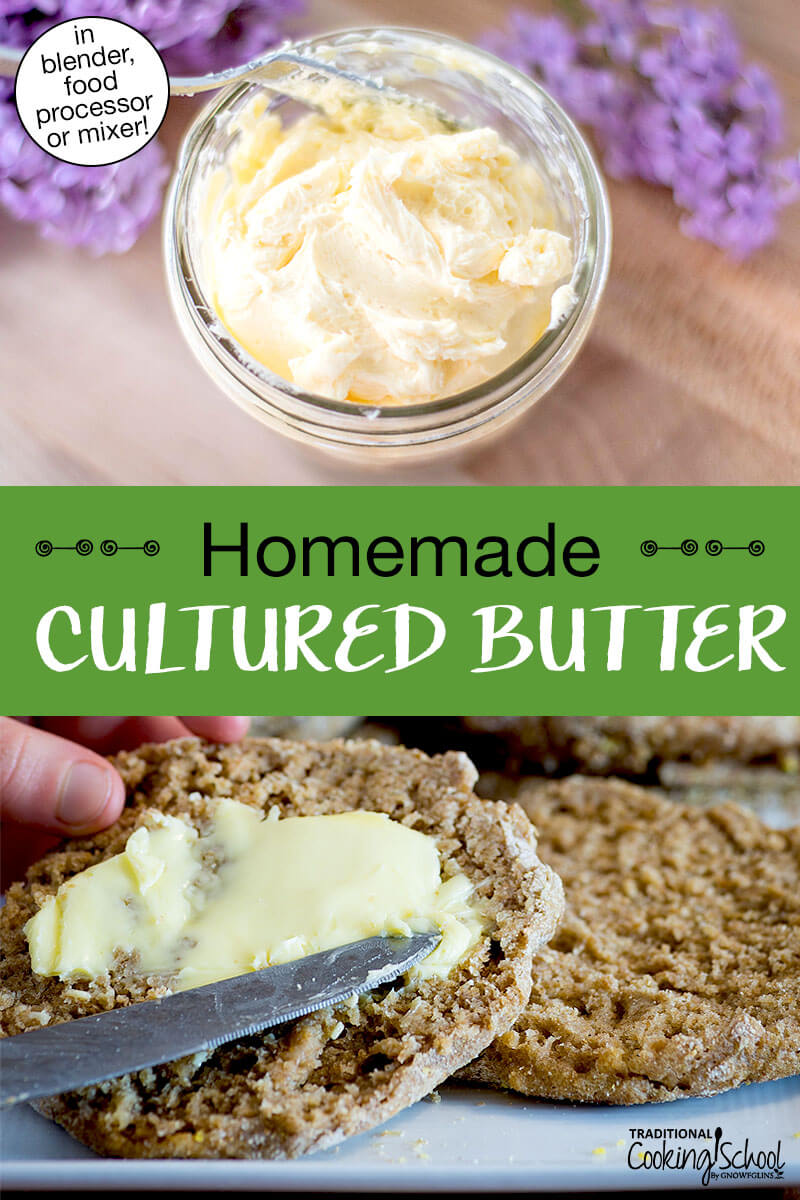
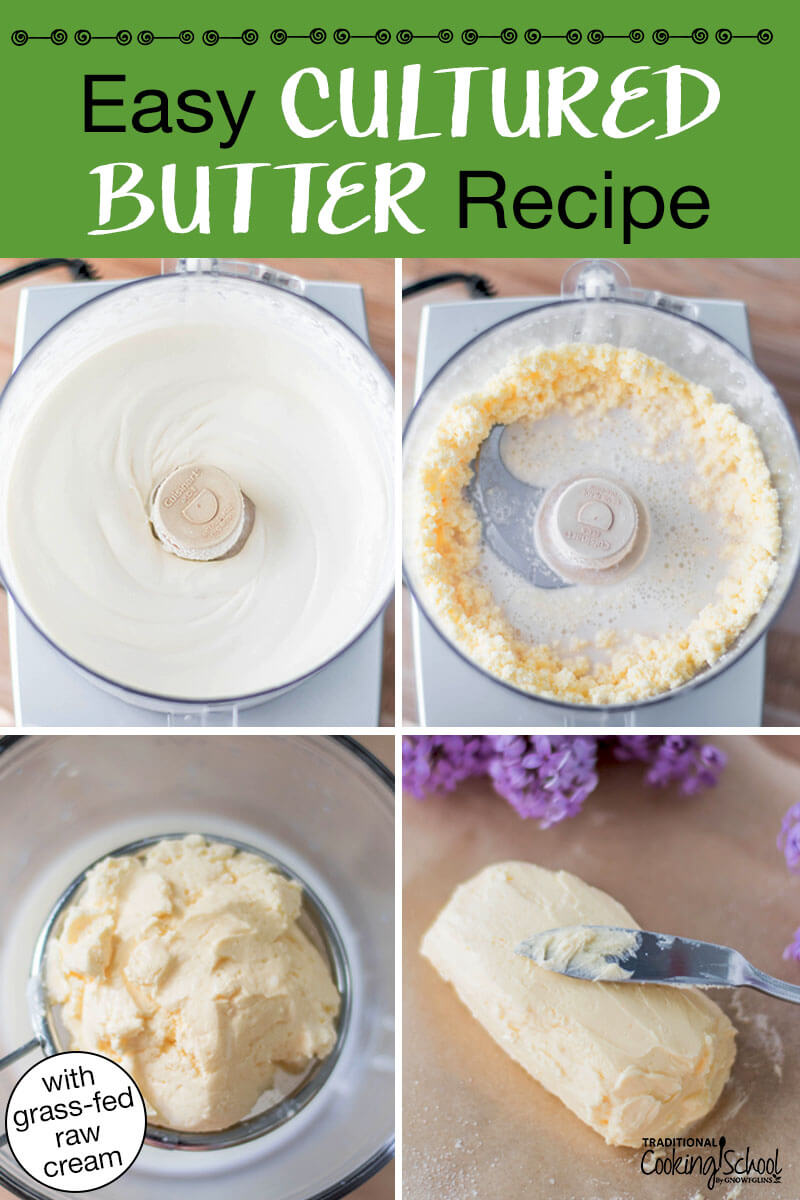
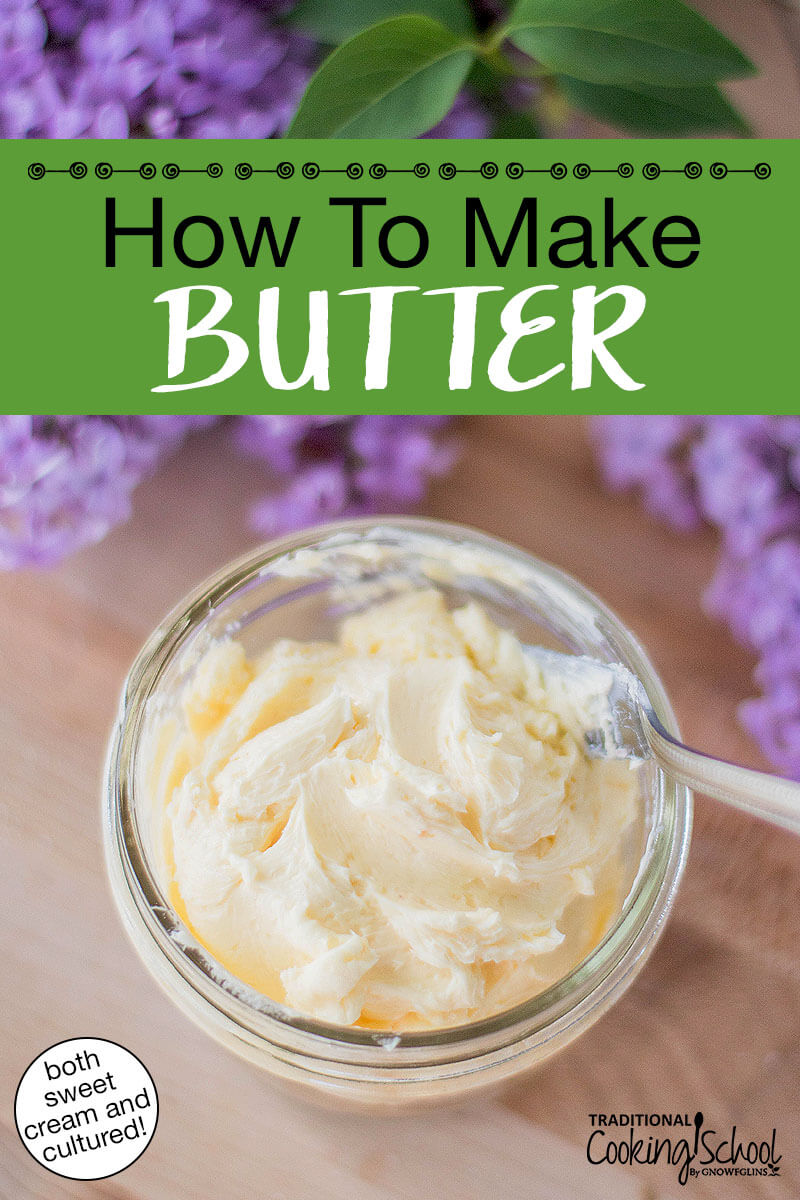
What a great post! I hope to have enough cream again to do this. As you know, I actually was able to culture the cream with a bit of kefir!
I have a half gallon of raw cow milk that has soured. This usually doesn’t happen here since we drink it fast. What do you usually do with soured milk? I was debating on leaving it out to separate, but I just stuck it back in the fridge.
Wardee, I attempted to make butter in my blender tonight. It started to look like it should, thicker and more yellow, but not yet clumpy, and then it turned back into looking like cream. Any ideas why? And now what should I do with it? It isn’t butter, and I have no idea how I can use it or if I can use it for anything.
HELP!
Julieanne
http://www.JoyInOurJourney.com
Julieanne — What temperature is it now? I wonder if it heated up in the blender? That would prevent it from “breaking” into butter. I’d try chilling it and then using a mixer or food processor to try again.
I looked online again, and none of the tutorials’ photos anywhere looked anything like my “butter” did tonight. Also used the rest of my cream to try to do this in the KitchenAid after looking at tutorials for that. Same thing happened. No butter. Well, after I rinsed it all, I think I ended up with 1 tsp. of butter, from 8 cups of cream. I feel so badly – this was a very expensive mistake and a waste of my evening. 🙁 Sometimes when I try to do things healthier and right, they don’t turn out, and I feel like giving up. Especially after using the cream from 3 gallons of raw cow’s milk, and having nothing to show for it.
I was so frustrated that I threw it all out. I wish I knew how to make butter so that it would work for Kelsi. She’s fine with the raw cow’s milk that we are now able to buy (!!!), so I was hoping she could use that butter so I wouldn’t have to buy trash margarine for her to use in the baked goods we make. We don’t need it very often, because I dislike using it so much, so I was really hoping that this would work for us.
It was strange. In the KitchenAid tutorials I saw, the cream got thick like whipped cream, and then did what I would expect it to do – get clumped a bit with obvious butter and buttermilk that were generally separate. But mine never did that at all.
I stored the bottles of milk in my fridge overnight without disturbing them so that I could skim off the full cream. I stored the cream in smaller pint jars in the fridge.
Everyone told me to take the cream out of the fridge 30-60 minutes before using it to make butter, so I did that.
It just never looked at all like any of the photos I saw online. I can’t think what I might have done wrong. It isn’t rocket science, you know! 🙂
Oh, well. I just feel like I’ve got to figure this out, though, because I really would like us to be able to eat raw butter instead of buying organic butter from the store. I could cry right now, but I’ll pray about it and trust that with the Lord’s help I’ll figure out some way to make butter in the future.
Thank you, Wardee,
Julieanne
It is best either cold or just 15 to 30 minutes out of fridge. In summer it can get too warm fast out of fridge. Also only the heaviest cream makes good butter. If the cream is too light it won’t make butter. I usually skim only the top firmest cream for butter and the rest is creamer for drinks or ice cream.
I hope to try this again, soon, with better results! 🙂
Julieanne
http://www.JoyInOurJourney.com
Julieanne, I have had this happen a few times..Two things..One let yer cream culture for a few days..Let it get just a little tart smelling..and Keep it chilled. The mixer method DOES warm it up and basically what happened is you were beating at too high a speed and it warmed up and collapsed..N it is NOT ruined..Put it in the freezer for twenty minutes and mix at low speed. Mine usually reocovers from this treatment. I have had it take as long as an hour to do so. I also use the marble in a jar method and same thing HAVE to keep it cool. The fat sticks together and the milky stuff seperates. This is caused by centrifugal force(in other words gravity. DO NOT use high speed to make yer butter unless it is VERy very cold. I have only used low speed since learning this and i does not take as long. Good luck Lady and hope it turns out better for you.
I also tried making butter from the cream at the top of my milk, however I found out it is no where near as thick as cream needed. It can only be the thick stuff at the very too that acts like a plug sometimes. That is the cream we need to make butter. Hope that helps. I am able to buy cream from the ssme place I get my raw milk it is very thick.
Cant wait to try this! I dont have raw cream so im using my kefir grains. No idea how i will find them looking at the cultured cream. But it looks damn tasty already.
I brought cheap super market cream to try cultured butter. Next time i might try to find organic grassfed cream.
You can make homemade cottage cheese with the curds
Tara – I would bake with it, or turn it into soft cheese. You can add rennet and let it set up, then drip it out through cheesecloth like the Fundamentals eCourse lesson. If you let it separate, you can drip it out then for cheese.
When I said bake with it, I meant use it for soaking my baked goods. I don’t cook good raw (even soured) milk without a very good reason! It would also be good in a smoothie.
I just recently took my heaving cream that was souring too much for my tastes in coffee, but I thought might make tasty butter, and put it my food processor. I knew it was thick, but was surprised when it turned to butter in less than a minute! It was mostly butterfat. And man, oh, man, was it some tasty stuff. I cooked some sliced carrots in it and then added a bit of chicken broth to feed to my toddler. Yummy! It really made plain carrots into something special.
Do you ever make butter from you goat milk? I’ve read that separators are expensive.
Thanks!
Love this idea your taking on “Probiotics” every meal each week. Great direction!
Now maybe my husband won’t think me a little tetch in the head for all the times he’s found me eating sauerkraut for breakfast with whatever else I’m having….LOL!! What can I say, I love kraut.
Enjoyed this post…….I had a failure with the cultured butter I did yesterday. Live and learn. The pig enjoyed the failure though! Nothing ever goes to waste if you’ve got a pig or chickens.
Just called my farmer gal “keeper of the grass fed jersey cows” to see if I can get an extra 2 gallons tomorrow on my milk run so I can have extra cream on hand for butter making. Although I may have a fight on my hands for the cream to be made into ice cream, but I think the butter will win.
Katherine – I have a separator, but haven’t used it yet. I have made cultured butter from whole goat’s milk. The yield is low, but the butter dreamy. 🙂
https://traditionalcookingschool.com/2009/06/22/homemade-cultured-butter-from-cultured-goat-milk/
Hi wardee, can you please re share the link for cultured goat butter? The one above isn’t working. Thank you so much!
Hi, Sydney.
I’m sorry, but that recipe is no longer available.
~Danielle, TCS Customer Success Team
Pamela – Here’s hoping the butter wins! Quite a difficult decision – butter or ice cream. So tough!
Sorry your last butter attempt didn’t work.
I been doing this for a long time, and my husband loves the butter. His question to me is always this: “Can’t you just make butter with the raw milk and leave it out on the counter? Won’t it ferment after its turned into butter?”
I don’t have an answer for him on that one. What do you think Wardee?
Heather – That’s a great question. I think I’ll have to ask someone to know for sure. I do know that there’s a problem with butter oxidizing when it is exposed to the air. That’s why a butter keeper is so good to keep butter fresh at room temperature. Perhaps suspended in milk, the butter solids are more protected from oxidation? I am really just guessing here. I think I’ll ask Julie @ Cultures for Health what she thinks. 🙂
If you have kids you can let them make butter but putting the cream in a mason jar, put a tight lid on and let them just shake shake shake it! It’s fun to see all the changes too and feel it how it goes from milky to the thick frothy stage (where you almost can’t shake it), till you start to feel the butter forming and jumping around in there then you see the lump of butter and milk. I did that recently with just a small leftover pint of cream I had in the fridge and I just wanted to try making butter with it. I just poured the “butter” milk off into another jar and saved it and just put it in pancakes ( I realized later that it’s not true buttermilk, I guess you have to culture it afterward?) but it was fun and the butter was delicious.
Hi Heather,
Wardee is correct, butter oxidizes and spoils at room temperature. The reason this happens to butter and not the original cream has to do with the size of the water droplets that are emulsified with the fat to form the butter. With raw cream, the bacteria in the cream is able to build and naturally culture the butter but the small size of the water droplets in the butter cause the butter to instead become rancid.
Hopefully that helps, but let me know if you have further questions 🙂
Julie
http://www.culturesforhealth.com
I had an interesting cultured butter experience…
I was a bit tired of the cultured taste and so I added some store bought buttermilk to my cultured cream and left it over night to develop. Then I chilled it and made the butter. It was strangely whiter in color but it was soooooooo good in flavor.
Nothing ever goes bad at my house any more…. it just ferments!
BTW – I kept this butter in a container in the refrigerator. It melts/softens real quick unlike store bought butter, so it isn’t a problem. Reminds me of how coconut oil behaves – from hard to soft real fast with just a little heat.
I was culturing (with a little bit of cultured raw buttermilk) some raw cream to make creme fraiche (sp?) and accidentally left it longer than the 20-24 hours. I actually left it about 34 hours and it looks like it is just starting to separate. My question is will it be okay as creme fraiche or should I try to make cultured butter with it? Or, is it bad since I left it longer than I was supposed to? I’m brand new to raw milk/milk products and culturing, so any help would be greatly appreciated!
Ashley – I think it is probably fine. It might be a little more grainy than smooth — but try mixing it a bit to see if you can smooth it out. You can make cultured butter out of it, but I think it is still fine. Try eating it and seeing if you like the texture. If you want to thicken it, you can “drip out” the buttermilk through a cheesecloth. Or you can make butter. But I think it is fine. 🙂
Thank you Wardee and Julie for your answers. That makes perfect sense. My husband was satisfied with that answer, he’s one of those ‘why?” people.
It really isn’t any more trouble to make it the traditional way anyway. We are so lucky to have an awesome source of milk from grassfed cows. The cream line is more than 1/2 way down the gallon. I plan to make ALOT of butter this spring and freeze it up for winter. mmmmm
Hi I was wondering if cultured butter is suitable to freeze. Does freezing affect the probiotics in anyway? Thanks
KC — Freezing is fine for probiotics. In fact, a great way to make them last!
This sounds great! I will try it really soon, unfortunately I can only by mainstream pasteurized cream. The uncultured butter I can buy is grass-fed but no grass-fed cream available 🙁
Will see what we like best. Or just culture every now and then or so.
Im embarrassed to say that I was actually throwing out my raw cream when it began to culture as I thought this meant it was off. Boy do I have a lot to learn! Heehee.
x
Wardee–how much butter did this make according to 1/2 gallon of raw milk (how many lbs?)? thanks
Kamille — Do you mean a 1/2 gallon of cream? It depends but generally you can expect half as much butter as cream. In terms of pounds, I’m not sure what that would be. If you had 1/2 gallon of cream, you’d end up with about 4 cups of butter.
Oopps–I meant cream, not milk. In the post you wrote that you started with 1/2 gal of cream and I wanted to know the ending results. 4 cups would be about 2 lbs. thanks!
Love all the info and comments – my mother taught me this old saying – hope it helps (I’m 80) – a pint’s a pound the world around.(generally)
Hi! I have a question for you. I just made some cultured butter from grass fed cream that I added some homemade yogurt to culture it. After I strained the buttermilk out from the butter(I used a clean pillowcase since I don’t have cheesecloth) there was a really thick cream left in the with the butter and on the sides of the cloth it looks a lot like the cheese you get when you strain the way out from yogurt. Is it really cream cheese or what is it? Thanx in advance if you can help me!
I’m so sad : ( I broke my food processor making butter last night! I’ve made it several times before. This time, I was about 2 minutes away from the butter chunks forming when the sound of the motor changes and the blade stopped spinning. The top piece of the lid that presses down into the central tube that turns the blade got so hot that it melted onto the metal spoke, essentially rendering it useless like a stripped screw. This is the 2nd food processor I have broken in a year! I tried transferring the cream into the blender but that didn’t work. So I finished whipping it by hand and got the butter to form. I just invested in a slow cooker finally this week, so I don’t have the funds to replace my food processor right away. argh, but thankful to have nutritious food and praising the Lord for his goodness anyway !
Is anyone else having trouble with this website being really slow or is it my computer? Anyway…it is a very helpful site! So, I tried making butter in my Vita-Mix on low and it didn’t work, It barely did a thing after 1/2 hour. I can make whipped cream in seconds in it on high, so we had, after trying low and medium, tried high to see if it made a difference. Nope. And it started to heat up. We rechilled it and tried again, and got a sour cream consistency but that’s all it would do. So then I read not to use a Vita-Mix. So will re-chil and try again in a blender with a wisk attachment, though I must say, the sour cream is tastey anyway. QUESTIION: I read elsewhere about what to do if a mold blob appears on top of soured milk, but I forget what it said, though it said the milk was still useable. If ever find this blob, do I mix it in, or take it off? QUESTION: Also, can I leave the jar of milk on the counter with it’s lid on to further sour it, or must I use a cloth cover? Is this what is called “clabber” . I read that this clabbered milk was good to obtain but foget what to do with clabbered milk. Thanks!
Hi, I’m wondering if the resulting buttermilk from the cultured butter can then be used as a starter to make more buttermilk using it and raw whole milk??
Hi Kinzi, have you found an answer for this? I would like to know also.
Hi, Kinzi and Kristy: Yes, you can! Please see this post (especially the notes at the end of the recipe): https://traditionalcookingschool.com/food-preparation/how-to-make-homemade-cultured-buttermilk-5-buttermilk-substitutes/
Wardee
I would like to try some cultured butter, but I don’t have raw milk. I DO have lots of water kefir – I don’t do dairy kefir, since I avoid dairy, but butter/milk fat is okay. Do you think that it will work to culture the cream with water kefir?
Thanks
Misty
I have been making butter from cultured cream now for over 12 months. I also have been making cultured sour cream among other cultured milk and cream products.
I have found that on occasions from one batch to another from the same farmer I’ll find that the cream just wont culture quite right. some times it just doesn’t seem to work.
any thoughts on what is going on? I am getting frustrated with it because when it works it is wonderful but i can’t figure out why it is working some times and other times not.
Please help!!!
So if I have raw fresh cream, do I need a starter or at all? Could I just place that on a counter for 24 hours…? Thanks!
Hello,
We bought our first organic raw milk 2 weeks.
Of the plastic bottles we poured some cream into a stainless steel milk can. We took some of this fresh cream to try and make butter, but it did not beat well the first day. Why? Then we let the rest sit in the fridge.
Looking at it today it has a brownish skin in parts and has already separated into curds and whey it seems. The brown skin looks a bit intimidating and even though the smell from the can is not too bad I would almost think to have to toss the brown skin or not?
We would be honoured if you could reply to this. Thank you.
Andreas and family
Hi Andreas,
I do remove the brown skin. It sounds like your cream is well cultured and ready to turn to butter. Be sure it’s well chilled before you start the process. Warm cream doesn’t work well for becoming butter. 🙂
I was making cultured butter from raw cream for 2 years. I then started getting raw cream and milk from a local farmer who had only a few cows instead of 200. They are grass fed Jersey’s instead of oat and grain fed Holsteins. For some reason, the cream will not culture and it does not churn into butter as successfully.
Do you have any thought’s or suggestions on this issue?
Hello!! This is a great post, as usual. I’m sorry if you had already explained this. Can you please give me some advice, and in turn help anyone else out there as clueless as I am (if that’s even possible! lol) in regards to culturing naturally?
If a person has access to raw cream, then they don’t need to get a culture starter, right? I leave the cream out for 24 hours (covered with a cloth) as you’ve mentioned above?
So, after the allotted time, I transfer the raw cream to the refrigerator. to slow down the culturing process and to make it cold enough for butter making? maybe an hour or so?
The resulting buttermilk from that cultured raw butter is now cultured raw buttermilk? Something I can then use as a cultured buttermilk to make future batches of cultured buttermilk or to culture fresh raw cream faster? Over and over?
I also have the option of culturing slowly, by buying the fresh raw cream and immediately putting it in the fridge, not leaving it out. Leave the raw cream in a glass jar with a screw on lid in the refrigerator for anywhere from 1 1/2 – 2 weeks (undisturbed) and it will automatically be cultured cream?
Hi Erika,
You can leave raw cream out to culture naturally. 24 hours should work unless your house is very cold then it may take longer.
Yes, after the allotted time, move it to the fridge to cool for ease of butter making. I usually move mine over in the evening to make butter the next day.
The buttermilk that comes off of butter is different than a cultured buttermilk. It doesn’t really work to make future batches of buttermilk. You can drink it (tastes great with a little salt) or use for baking, soaking grains, salad dressing, etc.
Yes, you can culture slowing in the fridge. Enjoy!
Millie
Traditional Cooking School Support Team
Wonderful! Good to know that I can also soak grains with the resulting buttermilk, even if that buttermilk isn’t the cultured kind that I hoped it would become. Thank you so much for your help!!! 🙂
I have a question, but first….
Oh my, I love you, Wardee. Just discovered you—maybe five days ago?—but it seems longer because I’ve been kind of binge-watching, searching, souring, and reading ever since. I love listening to your voice and your heart and your wonderful way of explaining things. You are a gifted communicator and excellent teacher.
Q: Is there a way to culture raw “buttermilk” (by which I mean the liquid by-product of making butter from raw cream) *after* I have made the butter? Can I just let it sit out in a covered jar and the organisms will do their thing?
My family doesn’t like cultured butter, but they love my homemade butter! 🙂
I would love to know if you have any tips for the best way to get the cream from a gallon jug of milk or off the top a bowl or glass jar. I have access to very good, organic, grassfed raw milk but not cream. I have in the past let it sit in the jug and by poking a hole in the bottom empty the skim and get the cream BUT this never results in getting all or even mostly cream OR wasting too much 🙁
Today I am trying for the first time leaving the jug of milk at room temp till tomorrow so it will be thicker when poke a hole to try to save only cream for butter but not sure that will work any better.
I am making butter by just leaving it out this time (first time making butter) and will also try with kefir grains in the future.
Thank you!! Susan
Hi Susan,
Wardee uses a 1/4 cup measuring scoop or a ladle to scoop off the top. Here’s a video from the archives!
https://traditionalcookingschool.com/2011/03/14/free-video-skimming-cream/
Millie
Traditional Cooking School
Thank you for this wonderful article! I am trying to figure out if I can use a probiotic capsule to culture the cream? I certainly have plenty of homemade raw kefir in the fridge, but thought I might benefit from using a variety of cultures. I don’t want to buy mesophilic cultures because I am not sure if I can tolerate them with my sensitivities. I like to work with what I know I can tolerate, for now. I can use kefir as a starter if not the probiotic capsules. Thanks!
Hi Syrena,
Yes. You can use a probiotic capsule. 🙂
Millie
Traditional Cooking School Support
We live on a dairy with what most people would consider grass fed cows. (Dairy cows cannot maintain health just eating grass and must have grain and other minerals. Also “grass” is seasonal so in the winter cows have to eat something else.) We drink raw milk and skim the cream and make butter several times a week. I notice an incredible amount of difference in the butter I make each time I make it! In the summer it is very yellow (probably from eating grass) in the winter it is light yellow. I have even seen it take on a greyish color. Sometimes it is fluffy and other times really firm. Also it seems to leave a lot of grease on my hands when I make it and other times not. Sometimes I can rinse all the buttermilk with a couple washes other times it takes ten rinses and it is still a little cloudy. I know some of this is related to what the cows are eating but what else do you think is going on? Also I have been told that using anything with a blade, like a blender, is the worst thing to use to make butter because the blade shreds up the molecules and will make the butter taste bad. Your thoughts? I prefer to use my blender because it works faster than anything else I have.
Hi Misty,
The difference in texture could be temperature of the butter solids. Yes, color varies season to season.
It’s interesting that a blade damages the molecules. That’s probably the same reason people say not to make mayonnaise with a blade. However, we’ve made good mayonnaise and good butter in a blender (neither of which taste bitter) so we’ll probably continue. 🙂
Millie
Traditional Cooking School Support
I realize this post was written a while ago so I have a couple of questions. If using the cream skimmed from the top of cultured “cottage” cheese, do you need to add sweet cream (raw/pasteurized) and let it sit in the frig to culture? I thought I would be able to go straight from skimming from culture to making butter. I want to make sure I am understanding correctly. Thanks in advance.
Hi Emily,
Using the cream skimmed off of the cultured cheese will give you perfect cultured butter. You don’t need to add sweet cream to it. 🙂
~Millie, TCS Customer Success Team
Thanks for sharing this recipe! How does changing the butter into its ‘cultured’ version have an effect on the taste? I don’t want my kids to go crazy and shy away from butter if it has a funky taste to it. If its all the same AND I get more probiotics I will be happy as a clam! Thanks again for sharing.
Hi Billy,
Culturing makes a slightly tangy and more flavorful butter. A little bit like sour cream (since this is essentially what you are using to make your butter).
We love it!
~ Millie, TCS Customer Success Team
As a child, my family used a gallon of milk every other day, but maybe every day. We’d keep the cream in the refrigerator until we had a little over a quart. Then we’d put it in the glass base of the hand crank butter churn. We’d leave it on the counter until it soured–a day or overnight. Then we’d churn and wash it as above. It didn’t take long to churn. We’d keep the butter in the refrigerator, but we’d always have a half cup or so on the counter to use on bread and toast. It was so easy to cook with since it softened so easily. And it tasted great. My sister and I would read the paper while we churned. Our local historical society has one of the crank churns. Beautiful memories.
I have yet to venture into dairy making other than making my own butter. I would like to make cultured butter as I like the flavor better, but…it makes me nervous to leave raw milk out for hours at a time! Would the 24 hour waiting period be less, say, in the summer? And how would I know if raw milk has gone bad? Also, what temperature is the best? How do you compensate for humid summers? Thank you for your help!
Hi, Lauren,
24-hours is not a hard-and-fast time. Even in the refrigerator raw cream will ripen on its own. Room temperature is between 68-77 degrees.
Fermentation time is often less in the summer because the heat makes the fermentation happen quicker. It could be 12 to 18 hours.
We normally don’t compensate extra for humidity, other than allowing for quicker fermentation in warmer temperatures.
~Peggy, TCS Customer Success Team
I was wondering how long is to long to let the cream set in the fridge before turning it into butter? I don’t have access to fresh cows milk, but I skim the cream from my yogurt that I make every 3 weeks…. could I wait 6 weeks or longer to turn that cream into butter???
Hi Micaela,
Yes you can wait that long (6 weeks). You might have a bit of mold grow at the top, which you can skim off. It will be more sour and have a stronger flavor.
~ Vicki, TCS Customer Success Team
Ok! Thanks! Can’t wait to give it a try!
Can I use pasteurized cream with a kefir grain in it for 24 hrs to “culture” would that be enough to make butter from as well?
Hi Micaela,
Yes you can although we don’t recommend ultra-pasteurized cream.
~ Vicki, TCS Customer Success Team
Can you make this butter with store bought heavy whipping cream? If not where can I buy the right cream?
Hi, Robin.
Yes, you can make it with store-bought cream but you will need to add a culture as pasteurized cream will not culture on its own.
~Danielle, TCS Customer Success Team
How long are you able to collect cultured cream to make butter? It would take me at least a month to collect 1/2 gallon, but I would think it would go bad by then.
Hi, Kylie.
If you’re using raw milk, it doesn’t go bad in a month, however it might be strong. 🙂
We haven’t had great success with freezing cream to make it work.
~Danielle, TCS Customer Success Team
I’ve tried frozen raw milk and frozen raw cream to make butter. I was not successful with either.
I’d love to try this. What should the ratio be for cultured cream to fresh raw cream? I just skimmed about 2 cups of cultured cream from my instant pot raw yogurt and have a half gallon of fresh raw cream in the refrigerator.
Hi, Mollie.
1 to 2 tablespoons cultured cream per 1 pint cream. 🙂
God bless you.
~Danielle, TCS Customer Success Team
Hi! I skimmed cultured cream off of my raw milk yogurt and had about a quart after a few yogurt batches. But after 5 minutes in the food processor, still nothing had happened. The hadn’t thickened at all! I had pulled it out of the fridge about 2 hours before. Any tips?
Thank you!
Abby
Hi Abby,
We’re not sure – sometimes its just trial and error. You could let it run longer. Also try cold cream instead of room temp.
~ Vicki, TCS Customer Success Team
I just successfully made butter from the cream that rose to the top of my raw dairy! I’d like to do cultured butter with the next batch using my milk kefir grains, but I have a few questions:
1. In the recipe above, does “raw sweet cream” = the cream I skim off the top of the raw dairy?
2. Any recommendations on how much kefir grains I should add to the cream I skim off?
3. Does the butter need to be refrigerated?
4. What can be done with the buttercream after making the butter? Can it be used in buttercream pancake recipes?
Hi Bob.
I’ve numberes my responses to your questions for continuity.
1. Yes
2. Use the same rule as for milk. 1 T per quart.
3. Yes.
4. It can be used for soaking or in recipes calling for an acidic liquid. This is different than whole milk buttermilk. If there’s any bitterness in your sour cream, it usually gets isolated to the buttermilk. You’ll know when your butter is churned whether or not you want to keep the buttermilk by the smell/taste.
Danielle ~ Customer Success Team
Hi, years of butter making tips – fresh cream needs to sit a few days before making butter. In my experience, it will keep up to ten days in the frig before starting to turn sour.
Also, the buttermilk left after the butter has clumped is delicious and sweet if drunk right away – within a few minutes after sitting it starts to turn sour. Commercial buttermilk is not the same as what is left after making butter.
Have you ever used smoked salt to season the butter? I was thinking of trying that this time.
Hi Amber, No we haven’t tried smoked salt in butter. Smoked salt can be a bit powerful so I suggest starting with smaller amounts then taste and add as you go. Let us know how it turns out – we would love to know!
~ Vicki, TCS Customer Success Team
Could butter be made with store bought sour cream? Ingredients say: cream, culture, salt. The food closet periodically gets a lot and most people don’t want to take it because they can’t use it up fast enough. This would be a great way to make sure it doesn’t get wasted.
Hi, Davette: Yes, you should be able to use store-bought sour cream to make butter. Give it a try, and let us know how it goes! — Sonya, TCS Customer Success Team
Hi Wardee. I am new to all of this. It is hard to find heavy cream in my area. But I can find heavy whipping cream. Is that the same? Also what is the recipe for the sweet cream butter?
Hi, Sharon.
Yes, you can make it with store-bought heavy whipping cream but you will need to add a culture as pasteurized cream will not culture on its own.
We do not have a separate recipe for sweet cream butter. You would simply skip the culturing step in this recipe.
~Danielle, TCS Customer Success Team
I bought a pint of raw cream and have had it in my fridge for a few weeks now. It definitely had a sour taste but nothing dramatic. I went and followed the steps, letting it sit out at room temp to ferment. It was already sour, then after more than 30 hours out it got more sour, seemed ready to go. Again, I followed the directions and put it in the fridge to cool completely. Then, removed it and let it get to room temp. Next, I put it in the stand mixer to let it do its thing- nothing! It was just looking foamy. I lowered the speed, let it go for more than 10 minutes and still nothing. Ugh. I put it back in its jar in the fridge now. Can I still save this or is it shot? I am a first timer and would love for this to actually work. I am obsessed with cultured butter and my local stores no longer sell it, but I would honestly rather make it myself!
Hi, Olivia: It’s possible that your fermented cream was too warm when you started the butter process. It should be at room temperature, but not too warm. So sorry this happened! You could try again, for sure! —Sonya, TCS Customer Success Team
I got my butter to break so I took it out & was using the wooden spoon method, but my texture of my body is kind of the whipped. Did I do it too long in the bowl or what I thought was breaking was actually not? Is it still good to use? This is my first try!
Hi, Aleya,
It could go either way, you could have taken it out too soon, or if you run it too long it get’s broken up again. I would say it is still good to use. 🙂
~Peggy, TCS Customer Success Team